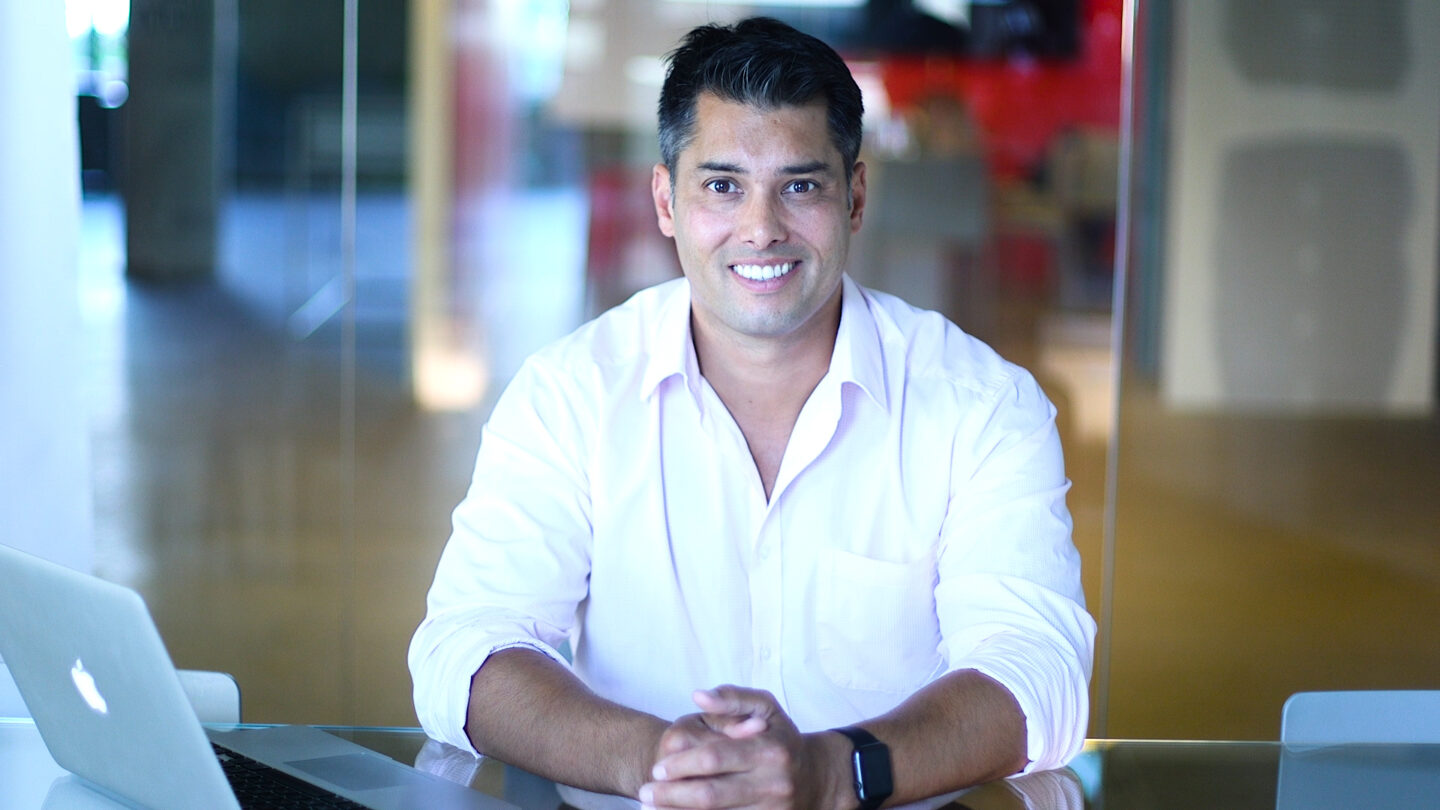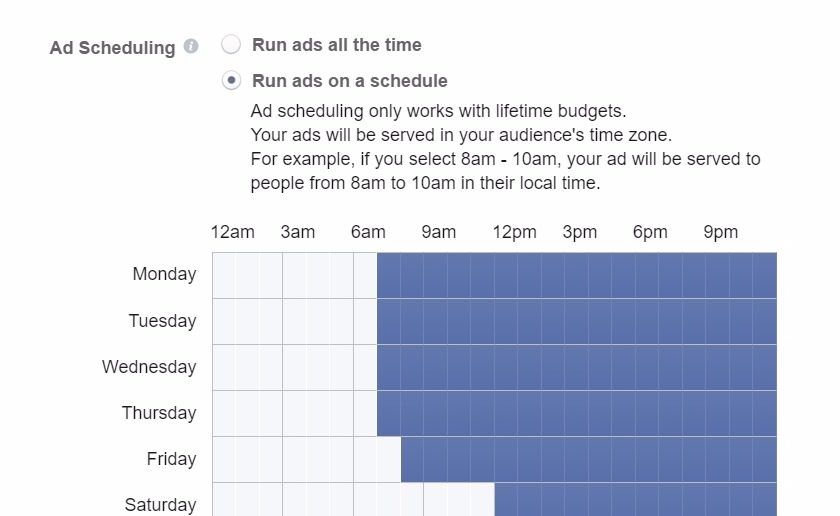When is the Best Time to Run Facebook Ads?


Almost every day you log into your Facebook Business account, you’ll find a new feature.
One feature that’s been a mainstay for a while now is Facebook Ad scheduling.
In the past, you may have chosen to skip this feature, and instead, set up a daily budget cap to run ads all day long.
But have you ever wondered if the time your ads appear might play a part in high CPCs or low CTRs?
We sat down with Moses Velasco, Chief Product Evangelist at Socialbakers, one of the world’s largest social marketing & analytics solutions providers, to find out if there is a best time to run Facebook ads.
It’s pretty simple to schedule ads in the Facebook Ad Manager.
First, log into your account and start the process of creating an ad.
When you reach the bottom of the page for selections, you’ll have the option to select one of two Ad Scheduling options:
If you do choose to run ads on a schedule, you must work with a lifetime–not daily–budget cap. Then, you can darken all of the spaces for the times you prefer your ads to get seen.

Once you’ve chosen your preferred days and times, you can select “Standard” (ads dispersed evenly throughout your selected times) or “Accelerated” (ads go out ASAP in your selected times) delivery.
Now, for an answer to the big question: Does it matter when you schedule your ads?

A. Yes, the messaging on your ads could change hour by the hour.
If you’re publishing something at seven in the morning and it happens to be about dinner recipes, it probably won’t go that far. You’ll probably have reach, but low engagement.
High reach but not as much engagement means your message is being seen, but you’re not capturing the attention of your audience.
You also want to be careful because if your message is at seven a.m. and it’s about breakfast, you may miss the tail end of engagement that comes after lunchtime.
Organic content actually has about a 72-hour life expectancy. And in that window, you’ll see that content can go from zero interactions to a nice curving arc and on to a peak that then will start to drop off around 72 hours.
That’s a unique scenario because you can decide based on the organic performance early in its lifecycle if it is something you want to promote. Otherwise, you probably don’t want to promote that content. Promoting poor performing content will lead to increases in CPC and CPM.
“The 2016 Guide to Facebook Retargeting“
A. I’d say that success with a Facebook ad isn’t completely determined so much by timing, but more on the quality of your content and how relevant it is to your audience.
What we’ve found at Socialbakers is that it’s extremely important to look at audience behavior over peak times–specifically, the actions your followers take.
What time do they engage with your content? Is it a share, like, comment, or click?
We’ve actually tried to move away from Facebook’s algorithm and we’ve created our own algorithm that measures your audience’s behavior. Sometimes it’s in line with Facebook’s algorithm, and sometimes it’s way different.
Through research, we’re able to determine the best day of the week and hour of the day to post, down to five-minute increments.
For example: If you want to publish something at six in the evening, our platform will let you know if you’ll see more visibility at seven-thirty.
We put that into a simple calendar schedule and make those recommendations so you can have maximum visibility with every post.
A. In a sense, if you post right at the peak times–also called “prime time”–you’ll miss a lot of your performance, especially the ramp up to the peak, which can carry your performance beyond that point, then if you posted right at the peak.
But content has a life of its own. When people see [your content] and they start to like and share it, it gains more priority in Facebook’s eyes.
If content is not relevant or interesting, it dies out and doesn’t have a life at all.
The challenge with paid content is that Facebook will push it to the newsfeed, and more people will see it, but there’s a bigger chance you’ll get negative feedback simply because it is being seen by so many people.
In that sense, you could actually end up paying for negative feedback–aka people hiding your post or requesting not so see anything else from your brand–if your content isn’t good quality. This will result in a lower relevance score.
A. [Facebook will] prioritize your content based on your relevance score. It has to be relevant and interesting to get the best ROI, reach, engagement, and conversions.
When you produce a lot of content and pay for it, and it’s not relevant, people will start to hide that content.
That will increase the amount of negative feedback you receive, which drives up your CPM and CPC.
Then, the next time you post something, you’re starting at a disadvantage. At the end of the day, if you put mediocre content in, you’re going to get mediocre results out.
A. Targeting and segmentation is important for the performance of your content.
You can be more relevant if you narrow down a group to target with your messaging, which means less negative feedback and an increase in reach and engagement.
The “broadsword” approach [(or trying to cater content to many groups)] with paid content can work, but it has to be extremely interesting to a wide variety of people.
Successful targeting and segmentation can really make a difference for ecommerce brands.
Our data shows that ecommerce top brands are receiving more interactions on Facebook than Instagram–and they’re using Facebook more than Instagram.
Companies and brands have been producing and promoting tons of content [on Facebook], which means spend has gone up.
However, we’ve also seen that interactions on posts have remained flat, so there’s been a diminishing ROI across the marketing industry.
To combat this, you need to focus more on targeting the audience you produce your messaging to.
Be as targeted as you can be–even on a regional or local level–with extremely relevant messaging.
Basically, create fewer [ads], but deliver them to extremely targeted audiences.
Ecommerce brands should also look into affinities and overlapping audiences–for instance, BMW audiences may also be interested in golf. So if you’re a golf equipment seller, target those BMW owners with your ads.
Brands can work on showing more people and fewer products–we see great examples of brands showing their team working on a product at the shop, or a consumer or influencer who really enjoys the product, which can really drive engagement.
One brand that stands out right now is ASOS.
ASOS gives individual accounts to their key influencers, so those individuals can post pictures (Read More- Facebook Picture Sizes) of themselves showing off ASOS fashion to their own followers. This is one way to build up a following that will indirectly build up the brand.
Another great one was this Xbox UK post, which definitely stands out from other pieces of content and encourages fans to get out and take action in the real world:
Also, user-generated content–if you’re not using it, you’re going to be left behind.
People today look at content and they review much more before they buy. User-generated content is another way to leverage a review.
It’s more authentic and interesting than branded marketing types of content. Brands should strive to have a great mix of branded/user generated content for their ads. They should also look to create connected stories and try to build on the audience’s [initial] attention.
A lot of users don’t understand how much control they have over the content they see–they can make small tweaks and adjustments that will determine what content gets cut from their feeds, and what stays.
You don’t want your brand to be the one that gets cut–so focus on high-quality content and targeting.

Notifications